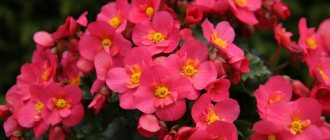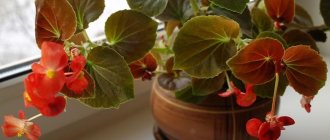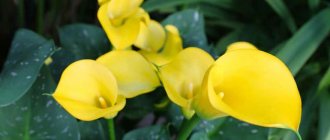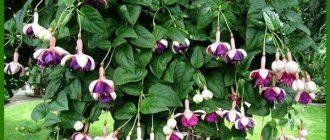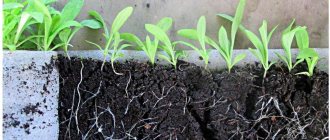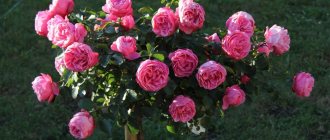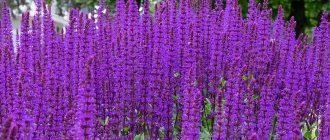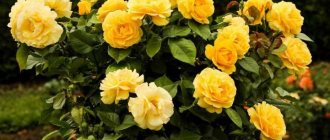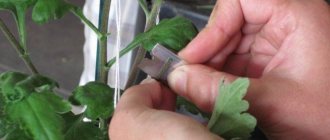While studying the nature of the West Indies, botanist Charles Plumier saw a flower of amazing beauty and was amazed by the grace of the flowering bush. It was a begonia. Unique varieties of this amazing plant still impress today with their diversity. Thanks to its special characteristics, garden begonia, which does not cause much trouble when planted and cared for in open ground, has become a favorite all over the world.
Plant characteristics
Tuberous begonia (Begonia tuberhybrida) is an unpretentious perennial plant. It looks great anywhere, is very versatile and extremely popular. Begonias were first described in history in 1690 by the French botanist Charles Plumiere. The name comes from another French plant expert, Michel Begon, and was used as a tribute. However, the delicate colorful flowers were known much earlier - according to historical sources, they were grown in China as early as the 14th century.
Numerous varieties make the begonia flower widespread and very popular among gardeners. The plant has been known in Europe for many years. Garden begonia flowers grow well in our climatic conditions; many varieties are created by crossing numerous species from Africa and the Andes.
Begonia is a small plant, the length of its shoots rarely exceeds 30 cm. The flower tends to branch quickly, which makes it even more attractive. It looks like a small bush decorated with beautiful flowers. The leaves are noteworthy - short, heart-shaped, fleshy and shiny, planted on rather long petioles.
Outdoor begonia blooms from June until the first frost, so it becomes the best decoration for the summer and autumn garden. Winter or ever-blooming begonia (Begonia x semperflorens-cultorum) is also known. Tuberous begonia owes its name to the fact that it forms underground tubers with the help of which it reproduces. Plants planted in the garden look very impressive. These flowers are also suitable for growing in pots, outdoor containers, and on balconies.
Flower for the quartermaster or the history of the name
Humanity owes the discovery and detailed description of several types of begonia to the Franciscan monk Charles Plumiere and the French intendant of the fleet Michel Begon.
Begonia in composition with ageratum
The first of them was a botanist, as they were then called a “plant hunter,” and the second simply dreamed of decorating Rochefort’s jurisdiction with unusual specimens of plants.
It was Quartermaster Begon who organized the expedition, during which Plumiere discovered an unusual plant in Haiti with asymmetrical leaves and soft pink flowers, shaped like butterflies.
Hosta - varieties and care
He named it begonia in honor of his patron, and later discovered several more related plants. Unfortunately, during his return to France, Plumiere lost his herbarium and seeds due to a storm, leaving only sketches. Michel Begon never saw the flower, thanks to which his memory remained in history.
Varieties and varieties of begonias with photos
It is difficult to describe in words what begonia flowers look like. Plant varieties represent a huge collection of different colors and shapes.
There are 2 popular garden species that can be grown outdoors:
- Tuberous (Begonia x tuberhybrida) with large multi-colored flowers.
- Semperflorens – ever-blooming or ever-blooming (Begonia semperflorens). Grows up to 50 cm in height, blooms from spring to autumn.
The following species are usually grown at home:
- royal (Begonia rex) - with beautifully colored leaves;
- winter (Begonia x hiemalis) - with extremely noble pink inflorescences.
Some species are annuals and require annual planting, while others, such as tuberous begonias, can overwinter.
There are tuberous varieties with semi-double, double and single flowers. Also popular is cascading ampelous begonia with much smaller flowers. Royal begonia does not produce many flowers; its leaves give it a decorative appearance.
Begonia varieties are difficult to count, their number is huge, as well as the number of variations and varieties. In the house and garden, standard tuberous begonia is most often grown, which is divided into 3 main groups. The criterion for division is the type and size of flowers.
- Large-flowered begonia (Begonia x tuberhybrida grandiflora) is the most popular variety. It differs in flower color and structure - they can have very jagged, fringed edges. The variety produces beautiful, double flowers, a bit like roses. The inflorescences have a diameter of up to 20-30 cm, although when grown on a windowsill they usually do not reach a large size. The flowers are white, yellow, pink, orange, red, burgundy, and there are two-color varieties, for example, white with a dark red border.
- Ampelous begonias are distinguished by the beautiful shape of the bush; they form thin, long, drooping stems. Hanging varieties are better suited for the balcony, where they look great in boxes or hanging pots - flowerpots. The shoots are covered with thin flowers that form large inflorescences and look very attractive. Varieties of hanging begonias differ in color and flower shape - some are simple, others are double, the most magnificent. Cascade begonia is the best plant for shaded balconies.
- Multiflora Multiflora (Begonia Multiflora Maxima) is not a garden begonia, the plant is suitable for a balcony, has tiny flowers. It looks great on the windowsill. Like the royal begonia, this is one of the most popular plants with decorative leaves covered with hairs and painted in different, most beautiful colors and patterns.
Popular varieties
| Name and description of the variety | Photo |
| Camellia bicolor (Bicolor Camellia) pink. The best place is a slightly shaded position, protected from the winds. The soil should be humus, permeable, and moist. Blooms in July – October. Grows up to 25-40 cm in height. | |
| Fimbriata white. White color. Variety: fimbriata - shaggy. Height: 20-25 cm. Flowering: June-September. Leaves in the shape of a heart. Flowers grow in the corners of the upper leaves, have a diameter of up to 12 cm, the petals are curled. | |
| Red fimbriata (Begonia fimbriata). Color: red. Variety: fimbriata - shaggy. Height: 20-25 cm. Flowering: June-September. The flowers are red, up to 12 cm in diameter. | |
| Orange fimbriata (Begonia fimbriata). Variety: fimbriata - shaggy. Orange color. | |
| Fimbriata pink (Fimbriata). Pink fimbriata shaggy. | |
| Fimbriata yellow . Begonia with yellow flowers. | |
| Grandiflora white (Grandiflora). Heart-shaped leaves, dense, succulent flower shoots. The flowers grow in the corners of the upper leaves, with serrated petals. The underground part is a flattened bulb covered with a thick dark brown skin. | |
| Grandiflora red bulbous (Grandiflora). Red flowers with serrated petals. | |
| Grandiflora orange. Orange serrated petals. | |
| Grandiflora pink. Pink flowers. | |
| White pendula (Begonia x tuberhybrida pendula). White color. Height: 30 cm. Flowering: June-September. Heart shaped leaves; thick, juicy flower shoots. Flowers grow in the corners of the upper leaves on hanging shoots. They reach a diameter of 7 cm. | |
| Pendula red. Pendula with red flowers. |
Subspecies
As a result of many years of selection and crossing of various classes of plants, a huge number of hybrids were eventually obtained.
Below are the most common ones.
Tuberous species
There are double, semi-double and smooth flowers. Color: white, soft pink, yellow, scarlet, bright red. The stem is fleshy and durable. This species is characterized by a long flowering process : from the first days of June to the end of November. When growing tuberous begonia outdoors, it is important to pay attention to certain nuances. In winter, the plant requires greenhouse storage.
Ampere
The length of the shoots hanging down is up to 80 cm. Falling varieties of hanging begonias look good when decorating outdoor vertical structures. They are grown in hanging flowerpots or on stands. Hybrid varieties remain attractive even with the onset of light frosts .
Everblooming
There are numerous varieties of this subspecies. The bushes grow small, up to 15-20 cm high. The foliage is oval-shaped, smooth in texture, and the color ranges from light green to brown. Used for decorating flower beds in parks and squares. The plants are not capricious; even beginners can care for them.
More details about the types of begonias can be found here.
Benefits of the plant
- Begonias bloom profusely throughout the summer until the first frost.
- Grows well in sun and partial shade.
- The choice between the available varieties is so great that you can choose between many interesting flower colors and different shapes, reaching from 10 to 30-35 cm in height, with straight or drooping stems.
- The flower can be grown in flower beds, in pots, containers, decorating terraces and balconies.
- Ready-made seedlings are widely available for sale in the spring.
- Young plants can be grown without problems at home on a windowsill by planting tubers bought in a store or stored from the previous season in early spring.
Cutting propagation method
This method is suitable for propagating any variety of begonia. It is necessary to cut off the top of the selected beautiful flowering bush, which should have at least three pairs of leaves. Closed buds and all flowers need to be trimmed. Before planting cuttings in the ground, their lower part must be treated with a special biologically active solution, which can be purchased at a flower shop or prepared independently. It consists of 200 g of water, as well as fresh aloe juice and honey (one tablespoon each). The shelf life of this drug is 48 hours at a temperature of 3 to 10 degrees Celsius. The depth of planting cuttings in the ground is 5-6 centimeters. The formation time of the root part is from 7 to 10 days, during which the cuttings should be under a film or glass cover.
Landing
Growing ever-flowering tuberous begonia is not difficult and is suitable even for amateur gardeners.
Tuber selection
It is important to choose the right flower tubers of the highest quality and prepare a suitable planting site. This is a sufficient guarantee that the plants will be attractive and resistant to disease and adverse weather conditions.
When planting, pay attention to ensure that the tubers are healthy, without signs of mold or rotting. The tubers have a characteristic cup shape, with buds located in the recess. In spring, pinkish buds are clearly visible on them, which indicates health and vitality. When planting, be careful not to break them.
Begonia reproduces from tubers, so it can retain the characteristics of the mother plant. Growing begonias from tubers is not difficult; seedlings and bulbs are usually purchased at garden stores.
Reproduction
In early spring (preferably at the end of February or March), the tubers are divided. This is the best way to propagate begonia. These plants can also be propagated by seeds or cuttings, but dividing the tubers is most effective.
The tubers should be divided so that each one has at least one healthy bud (the so-called ear). Wounds caused by dividing tubers should be treated with charcoal and allowed to dry during the day. Coal can be purchased at a pharmacy; the tablet must be crushed with a knife. This will additionally protect the plant from fungal diseases and rotting. After 24 hours, they begin planting.
Choosing a planting site and soil
Garden begonia, like balcony and potted ones, prefers not to be in the sun. These plants love shade. In a sunny place, the stems are a little thinner, the plant has problems with flowering, and the fleshy leaves are easily burned during the heat. They definitely do better in the shade. That's why they often have other plants in their company: conifers that shade the flowers. For balcony growing, an eastern or southern balcony, but shaded by an umbrella, is suitable.
It is better to choose a planting site protected from the wind, especially for cascading varieties. Fragile stems cannot withstand strong gusts of wind.
The soil should be:
- slightly sour;
- humus;
- quite loose;
- permeable;
- You need to pour a small layer of drainage into the pots - expanded clay, gravel.
Use flower soil mixed with acidic peat and compost. You can add a hydrogel to the soil, which retains excess water and releases it when the substrate dries.
Pots are selected as follows:
- for 1 tuber choose a pot with a diameter of 9-12 cm;
- a pot with a diameter of 15 cm is enough for 2 small tubers (2.5-7 cm in size) or one large one;
- for 3 tubers a good flowerpot or basket with a diameter of 25 cm is suitable;
- there should be 2.5-3 cm of free space around each tuber.
Begonias grow well at temperatures of 20 degrees Celsius, so you can easily grow them on your windowsill at home.
Landing dates
Tubers are planted in pots about 3 months before the planned end of frost - this is the end of February or the beginning of March. If you want the plants to bloom in summer or late spring, it is better to plant in March. Later the plant will take root, but may not have time to bloom or flowering will be greatly delayed.
Planting tubers
Begonia is a plant grown from underground tubers that look like flower bulbs. Growing begonias in the garden and pots on the balcony begins with choosing tubers. It is better to buy flower bulbs from a reliable manufacturer. By the time of planting, the tubers may have buds - a sign that they are healthy and in good condition. You need to be careful not to break or destroy the kidneys.
Begonia requires a very special planting method.
Planting stages:
- Moisten the purchased soil with warm water.
- Fill the pot with soil to a height of about 5 cm from the top edge.
- Make small holes in the ground for each tuber to such a depth that once placed, the top of the tubers is on the surface.
- Plant the tubers in holes in the ground with the concave part pointing upward. If the tuber doesn't have an indentation on either side, look for a tiny pink bud or eye to show the top of the tuber.
- Carefully cover the sides of the tuber with soil, do not cover the top part.
- Place flower pots with begonia tubers in a bright place where the temperature is above 13 degrees Celsius. You can cover the pots with glass or a plastic bag.
- Water the tubers with room temperature water to keep the soil moist. As the plants grow, they need to be watered with more water and more often. Try not to water the area where the leaves grow. You need to pour enough water so that it protrudes onto the stand. After waiting half an hour, empty the drained water from the stand.
- The plant is fertilized once a week with fertilizer for flowering plants.
Hardening, transplanting into soil
Before transplanting into the ground, it is worth hardening the plants for several days - taking them out into fresh air for several hours, gradually increasing the hardening time.
Begonias do not tolerate frost, so it is safer to move or transplant them outside after May 15th. When replanting to a permanent place (beds, containers), you need to carefully lower the plant into the holes, trying not to damage the root ball.
Care
Growing begonia is not difficult. Garden, royal, and ampelous varieties have fairly similar requirements.
Watering
The plant has a high need for water and nutrients. The soil should always be slightly moist, but not wet. Therefore, begonia must be watered moderately, increasing the intensity of irrigation during periods of increased growth. Do not water with too cold water, otherwise spots will appear on the leaves.
Attention! Do not overwater your begonia. The soil should not be too wet, because the plants will rot along with the tubers.
Fertilizer
Fertilizer application is an important element of care. Begonia has a high demand for minerals; the cascade variety is especially demanding of fertilizers. Therefore, like all perennial flowers, you need to feed them quite often. Use ready-made preparations intended for begonias. You can also use fertilizers for other shade-tolerant acidophilic plants. Feeding is carried out throughout the season. The best way to fertilize is to apply fertilizer with watering.
Garden care in autumn, wintering
Garden begonias are not entirely frost-resistant, so if they are grown as perennials, you need to make sure they don't freeze before winter sets in. In late autumn, the tubers are removed from the soil and, after clearing of shoots and leaves, placed in a ventilated container.
Hanging begonias growing on balconies should be treated in the same way. Immediately after the first frost, the plant should be removed from the containers, carefully shaken off the ground and trimmed at a height of about 2 cm above the tuber. After 1-2 days, when the soil is slightly dry, it is necessary to clean the tubers from any remaining soil, remove affected and damaged tubers, leave good ones in a ventilated place.
The tubers are placed in cardboard or wooden boxes and covered with peat or sand to prevent them from drying out. The temperature in a room without windows should be 3-10 degrees Celsius. Tubers overwinter in this way until spring in a dark, dry place.
If begonias are moved home for the winter, they need to be given a few months to rest from flowering. Even in hot climates, plants need rest.
Bet on contrast
When choosing begonias, the gardener should not limit himself to one “classic”. After all, flowers must be different in order to dance in a circle of colors in front of their suitors and more.
In this regard, the begonia flower is ready to offer hanging varieties:
- "Rocsana" - stands out with large yellow flowers;
- "Kristy" - has double white inflorescences;
- “Girl” – opens with pale pink inflorescences;
- “Santa Cruz Sunset F1” - at the time of flowering it grows with red-orange “caps”;
- "Copacabana F1" - shows bell-like bright red flowers;
- “Bossa Nova F1” is strewn with fuchsia-shaped flowers, the color of which varies depending on the subspecies.
The “lights” of ampelous varieties are held on long falling stems, and the last three belong to the Bolivian begonia. They boast of their spreading nature and strong stem system. These features give the Bolivian begonia resistance to frost.
Growing in pots
Potted begonias sometimes resemble tiny roses, which is why they are very popular. Caring for potted varieties is very similar to growing garden varieties.
- Landing place. The main thing is to provide shading; the flower grows well on northern windowsills without sun. Similar requirements apply to the beautiful royal begonia, which is found more often in homes than other species. The tuberous variety can be grown indoors all year round - it does not need a wintering period. The plant looks great in the back of the room - on shelves, on a table.
- Watering . The plant needs fairly regular irrigation - it cannot be filled with water in a pot, but it does not like even temporary drying out of the soil.
- Feeding . If you want to get thick, beautiful flowers, you need to take care of regular fertilization throughout the season - from February, March to late autumn. This is very important because begonias in pots have a very high demand for minerals. Properly selected fertilizers will be the best way to maintain an adequate level of substrate acidity. For this reason, it is worth using preparations specifically designed for fertilizing begonias.
Conditions for keeping begonias depending on the season - table
| Season | Feeding | Lighting (always diffused, partial shade) | Watering | Temperature |
| Spring | 1 time every 2 weeks | keep on the north window | moderate, in a tray when the soil dries to a depth of 1–2 cm | +17… +25 ⁰C |
| Summer | 1 time per week | |||
| Autumn | 1 time every 2 weeks | move to west or east window | room, not lower than +13… +15 ⁰C | |
| Winter | 1 time per month |
Rooted begonias in such conditions will bloom all year round or for many months (depending on the variety). For tuberous begonias, this table is only partially suitable. In autumn they are cut and stored for the winter in a dark and cool place (+12 ⁰C). Water once a month, only slightly moistening a strip of soil along the edge of the pot. At the end of February they put it out in the window, begin to water and feed it, like all other flowering varieties.
Video: Tuberous begonias: dormant period and cultivation
Diseases and pests
Tuberous varieties of begonias do not get sick often. Sometimes they are attacked by aphids. Sometimes fungal diseases occur:
- powdery mildew,
- gray mold,
- spotting,
- rotting.
You can reduce the risk of disease by growing plants correctly and following the watering regime.
Photo. Powdery mildew on begonia leaves
